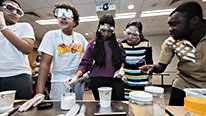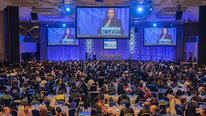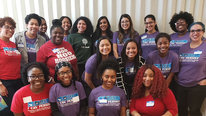- Breanna Ondich
- https://www.ecology.uga.edu/directory/breanna-ondich/
- Public Service Professional - Emerge Program Coordinator
- Presenter’s NSFRESOURCECENTERS
- Society for Freshwater Science, University of Georgia
- Checo Colón-Gaud
- https://www.linkedin.com/in/checo-colon-gaud-0b8611163/
- Associate Dean
- Presenter’s NSFRESOURCECENTERS
- Georgia Southern University
- Matthew Kellam
- Sound Designer, Editor
- Presenter’s NSFRESOURCECENTERS
- Freshwaters Illustrated
- Daniel McGarvey
- http://www.mcgarveyecology.com
- Associate Professor
- Presenter’s NSFRESOURCECENTERS
- Virginia Commonwealth University
- Patina Mendez
- https://nature.berkeley.edu/patinamendez/
- Continuing Lecturer
- Presenter’s NSFRESOURCECENTERS
- UC Berkeley
- Jeremy Monroe
- https://www.freshwatersillustrated.org/fi-team
- Director
- Presenter’s NSFRESOURCECENTERS
- Freshwaters Illustrated
- Amy Rosemond
- http://rosemondlab.ecology.uga.edu/
- Professor
- Presenter’s NSFRESOURCECENTERS
- University of Georgia
- Amanda Rugenski
- https://www.ecology.uga.edu/directory/amanda-rugenski/
- Lecturer & Graduate Faculty
- Presenter’s NSFRESOURCECENTERS
- University of Georgia
Choice
Emerge: Broadening Participation and Leadership in Freshwater Science
NSF Awards: 2032146
2022 (see original presentation & discussion)
Undergraduate, Graduate, Adult learners
Scientific societies, such as the Society for Freshwater Science (SFS), provide a level of geographic and temporal cohesiveness that is difficult to produce in other contexts. Sustained peer-peer and peer-mentor relationships are one outcome of this cohesiveness that may play a particularly important role in efforts to recruit and retain underrepresented minorities in STEM, given the recognized benefits of peer mentoring and a strong sense of group identity for underrepresented minority persistence. The SFS Emerge program aims to be a transformative training and mentoring program to help underrepresented minority individuals pursue careers in the freshwater sciences.
Learn more about the Emerge program:
Related Content for Broadening Participation & Leadership in Freshwater Science
-
 2019Seeding the Future with Change Makers
2019Seeding the Future with Change Makers
Rajeev Rupani
-
 2019Blending Transparent Soil, Coding, and Scientific Research
2019Blending Transparent Soil, Coding, and Scientific Research
George Barnett
-
 2017Seeding the Future through Social Justice Driven STEM
2017Seeding the Future through Social Justice Driven STEM
Mike Barnett
-
 2022Advancing Science Identity in URM Emerging Researchers
2022Advancing Science Identity in URM Emerging Researchers
Iris Wagstaff
-
 2020CAHSI: An NSF National INCLUDES Alliance
2020CAHSI: An NSF National INCLUDES Alliance
Ann Gates
-
 2021ChangeMakers: Youth led mentoring around food justice
2021ChangeMakers: Youth led mentoring around food justice
Rajeev Rupani
-
 2020Food Justice Driven STEM: Creating Changemakers
2020Food Justice Driven STEM: Creating Changemakers
Rajeev Rupani
-
 2022Impact of LGBTQ+ instructors coming out in science courses
2022Impact of LGBTQ+ instructors coming out in science courses
Nicholas Wiesenthal
Playlist: Broadening Participation in STEM by…
Broadening Participation in STEM by Focusing on Identity Development
-
 2022Advancing Science Identity in URM Emerging Researchers
2022Advancing Science Identity in URM Emerging Researchers
Iris Wagstaff
-
 2022Longitudinal Study of STEM Pathways
2022Longitudinal Study of STEM Pathways
Preeti Gupta
-
 2022Broadening Participation & Leadership in Freshwater Science
2022Broadening Participation & Leadership in Freshwater Science
Breanna Ondich
-
 2022Centering Women of Color in STEM: The ICP STEM Initiative
2022Centering Women of Color in STEM: The ICP STEM Initiative
Kerrie Wilkins-Yel
-
 2021Illuminating Career Pathways Through SEAS Islands Alliance
2021Illuminating Career Pathways Through SEAS Islands Alliance
Lisa Tossey
-
 2021My STEM Story: Students Explore Science Identities
2021My STEM Story: Students Explore Science Identities
Ed Madison
-
 2022Exploring geoscience careers to enhance STEM representation
2022Exploring geoscience careers to enhance STEM representation
Meagen Pollock








Daniel McGarvey
Associate Professor
Hi Folks!
Dan McGarvey here. I'm part of the Leadership Team for the Emerge project. We are just about to start the 2nd year of project activities and we're excited to meet a new cohort of participants next week in Grand Rapids, MI, where a LOT of aquatic scientists will be assembling for the 2022 Joint Aquatic Sciences Meeting.
In a nutshell, the Emerge project is trying to maximize interest in freshwater science, particularly among college-age students from underrepresented backgrounds. We recruit participants from 3 main groups: college, grad school, and early career. We use a combination of live events (e.g., fieldtrips on different rivers and 3-day technical workshops) and online events to build and sustain a sense of community while adding some new technical skills in the mix.
Over the next several days, I and my co-presenters will do our best to answer any questions you may have about the Emerge program. But for the moment, I recommend checking out our program poster from the 2021 Annual Meeting of the Society for Freshwater Science. The poster does I good job (I hope!?) of summarizing how Emerge is structured and how the various activities work.
Amanda Rugenski
Stephen Uzzo
Chief Scientist
Thanks, Dan, for sharing this great work. How is inclusivity working? Are you keeping demographic information, and how do you measure success? Are you finding that the groups you work with share their cultural funds of knowledge as part of their participation in the program?
Amanda Rugenski
Daniel McGarvey
Associate Professor
Hello there Stephen. The inclusivity part is baked-in. We require background/demographic information when participants send their applications in, then we use that info to maximize diversity when we build each cohort. Yes, this does mean the application itself is a selective (but not unduly competitive) step.
One of the best parts of Emerge is that we found an extremely engaged and capable assessment group to work with us. Prior to submitting our grant proposal, we had some good conversations with Strategic Evaluations, Inc. (SEI), then really built their services into the grant. SEI has been wonderful to work with. They collect feedback from our program participants immediately after each of our structured events/workshops, then conduct live focus group interviews at the end of the program year. We're just now wrapping up the first year and excited to see what this first round of assessment data tells us!
Amanda Rugenski
April Jubett
This is so inspiring. I love hearing how this program has changed things for kids who were feeling discouraged.
Amanda Rugenski
Daniel McGarvey
Associate Professor
Thanks for that, April. The peer/community benefits of the program are really the most important part. The Emerge proposal took a deep dive into the theory of "scientific integration", but at the most fundamental level, we mostly trying to show the participants (A) that they really do belong in this field and that if they are brave and motivated and really stick it out, they will in fact become fully successful aquatic scientists; and (B) they will not be alone as they work through the long and difficult professional training process.
I'm particularly glad to get a comment from you. It led me to check out your video on sonification as a medium for science communication. And broad science communication is the other "bigger than science" cause that I am trying to support in my career. I'm doing that through visual digital media. Namely, teaching graphic design to STEM students, most of whom have never thought hard about design principles or worked with vector-based graphics software like Illustrator or InkScape. If fact, one of the technical workshops that we use to train the Emerge participants focuses on precisely these skills.
Keep up the good work. . .
Amanda Rugenski
George Hein
Professor Emeritus
Thanks for sharing you program with us. As a former evaluator, I'm delighted to hear that you recognize that working with a good evaluation group helps to build the program. I know that NSF requires an evaluation plan, but it isn't always the case that the program managers start working with the evaluators early and actually mutually shape the activities to take full advantage of what evaluation requires.
Amanda Rugenski
Daniel McGarvey
Associate Professor
Hi George. Working with Strategic Evaluations has been a great learning experience for me and the entire leadership team. I've never worked on a project that had a true, comprehensive evaluation mapped out and fully budgeted like this. But I'm pleased to say the evaluation process has been really engaging and fun so far!
Folashade Solomon
Associate Professor
What did you learn from year one that you will change or add on to in year two?
Amanda Rugenski
Daniel McGarvey
Associate Professor
Good question! We're in the process of conducting the live focus group interviews to wrap the Year 1 activities, so the jury will be out for a little while longer. But one key lesson that I PERSONALLY (not necessarily speaking for the entire leadership team here) learned in a visceral, real-time way throughout the first year is that I've been trying to shoehorn too much technical content into our live workshops. The first workshop was an intensive 3-day event on R programming and analysis of NSF NEON data. The second was a 3-day crash course on graphic design, using InkScape software. I lead both workshops and coming into them, I didn't have a super accurate intuition of how much ground we should try to cover. We probably overflowed somewhat at both workshops, so I'll be factoring that into the Year 2 workshops.
In terms of trying to promote the group/peer/cohort dynamic that we are emphasizing so heavily, we probably won't change much. All signs suggest this part of the project has been a huge success! The Year 1 cohort first came together just about a year ago, and has been reunited live 3 times since then. But in between events, there has been a lot of direct communication and group chatter among the participants. Despite being in different locations all across the country, they've clearly become friends and that has been wonderful to see!
Amanda Rugenski
Patina Mendez
Patina Mendez
Continuing Lecturer
As Dan mentioned, we have a lot of "between-workshop activity". We have year-round collaboration with monthly meetings where we meet in a virtual online space. In these meetings, the participants are in teams that they work with on activities that are process skills we all need in science and when working on long-term projects. We have found it's filled the gaps for some fellows and allowed others to peer mentor. So they fellows really got to know each other in these spaces. We've learned a lot about how time conflicts can be a problem for people to get together even online, so we'll be working on negotiating that even more in year 2.
Amanda Rugenski
Folashade Solomon
Associate Professor
Thank you. I am looking forward to learning more about how the second year goes.
Amanda Rugenski
Daniel McGarvey
Associate Professor
Not as much as us!
Amanda Rugenski
Lisa Dierker
This looks like an amazing program and love that you are getting students outside to experience science first hand! Are any of the program activities earning college credit specifically or if this a meaningful enrichment on top traditional courses? The NEON+R piece is wonderful and if any of our materials from the Passion-Driven Statistics project might be helpful, we are eager to share. We have a series of accessible R videos (https://www.youtube.com/playlist?list=PL2fQHGED...-) and our e-book provides a walk through the research process involving students in real data analysis (https://bit.ly/PDSe-book). To achieve my wildest education dreams I would love college courses to look like your program.
Amanda Rugenski
Daniel McGarvey
Associate Professor
Unfortunately, this is external to the participants' university transcripts. Creating universally transferable curricula would require a time commitment that simply wasn't budgeted in the grant. Moreover, I doubt our 3-day lesson plans would gain much traction in a 1, 2, 3-credit system. That's why we're being so tactical in the specific lessons we teach: it's cherry-picked, super contemporary stuff. For example, we focused on insect functional trait analysis in the first NEON + R workshop. These are premium skills in freshwater research, but probably not a block of skills that universities will quickly adopt as transfer credit. That said, we are currently working on our first journal manuscript based entirely on the workshop results. . .
I'll definitely be reading up on your stats lessons. I loved your video and concept!
Ravanasamudram Uma
It is so heartwarming to see the direct impact of your project on students. Particularly that student who said she had almost given up on STEM because she didn't think she had a future in it. Kudos!
Patina Mendez
Tracy Holbrook
Loved how your video told the story through the eyes of the students who are participating in your project. I noticed a couple of mentions concerning virtual learning and other time-commitment activities for these students and learners. Have you experienced any problems with scheduling such as weekend work schedules that interfere with some of your project requirements? What was the biggest obstacle when you launched your project?
Patina Mendez
Continuing Lecturer
Thanks for this comment. We really like hearing the voices and stories too, which is really a strength of our program because the fellows really do talk to each other and listen to each other's experiences. We are really working on building communication and trust because it's one of the big things we have to navigate as scientists in collaborations. We do have a year-round virtual program-- and the scheduling can be a challenge especially because we're in different times zones. The approach we took with it was to have as many people come live to our monthly collaboration meeting and also record the session. Then fellows who can't make it can watch the short session and meet up with their team to do the asynchronous task. That session plus task part of the program is really meant to be an investment of about 2-4 hours per month where fellows read papers together, work with code from the workshops and just have time and space to work at their own pace. The monthly sessions have reflection/metacognition components as well that focuses on process. I can speak for myself here, but I think the biggest obstacle has been as you say, getting everyone into the same room with all of the schedules. I think this coming year we'll schedule everything early so that conflicts will be fewer.
Michelle Perry
This seems AWESOME! How do you find the participants? How do they find you? Are there lessons to share for broadening participation beyond freshwater science?
Daniel McGarvey
Associate Professor
Hello there Michelle. Recruitment has primarily been through word-of-mouth. As you probably guess, that made things tricky in Year 1. Each of the co-leads was really shaking the bushes among our own networks for applicants. We filled out a strong Year 1 cohort, but were not overwhelmed with a huge number of applicants.
I'm happy to say in the 2nd year, recruitment has been easier. Word has traveled so there is some 'passive' recruitment happening. But we also now have some alums telling their friends about first-hand experiences, their advisers are speaking out for us, and with some Year 1 deliverables (like our Showcase video), we have better media to work with.
In response to your latter question, the answer is definitely "yes"! It's true that Emerge is wrapped in a freshwater science blanket, but that is really just a matter of setting and logistics. In reality, the Emerge recipe is simple: (1) assemble cohorts that are comprised entirely of underrepresented individuals, so they will feel safe and at ease more quickly; (2) bring them together as often as feasible and use online tools to maintain connection in between live events; (3) provide training in some "premium" technical skills so they will feel confident and empowered as fledgling scientists; (4) remind they constantly that what makes them special is not their bullet list of professional accomplishments, but the really unique personal stories they bring to the table. I would image this process can be replicated in any STEM discipline, so long as a dedicated team of leaders/mentors is on board and there are sufficient financial resources!?
Further posting is closed as the event has ended.